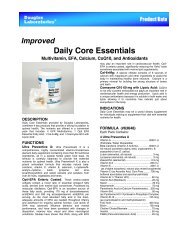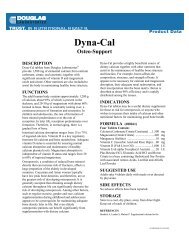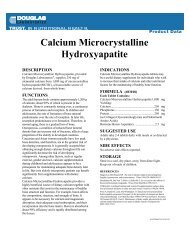Douglas Laboratories NutriNews FINAL
Douglas Laboratories NutriNews FINAL
Douglas Laboratories NutriNews FINAL
Create successful ePaper yourself
Turn your PDF publications into a flip-book with our unique Google optimized e-Paper software.
diet. On the other hand, if cP450 is determined to be underactive,it is necessary to address factors that cause this downregulation.Factors which down-regulate cP450 include:under-nutrition, fasting, protein deficiency, phosphatidylcholinedeficiency (PUFA deficiency), benzodiazepines (Halcion,Librium, Valium, etc.), Antihistamines, Cimetidine (Tagamet),Ketoconazole, Sulfaphenazole, naringenin from grapefruitjuice, vitamin C and A deficiencies, and bacterial endotoxins.Once Phase I activity is proportional to the toxic load,additional support may be required for Phase II conjugationactivities. Based upon liver detoxification test results, or clinicaljudgement, specific or generic Phase II support is often indicated.One type of phase II conjugation is adding an acetyl groupto a cP450-produced metabolite. There is great individualvariability of acetylation rates. Acetylation detoxifies sulfonamidesand mescaline. Acetylation is inhibited by deficiencies of vitaminB2, B5, or Vit. C. There are no known inducers.Glutathione is an important conjugating molecule.Glutathione is a tripeptide composed of glutamic acid, cysteineand glycine. The conjugation of glutathione with intermediarybiotransformed xenobiotics from Phase I results in theexcretion of mercapturic acids. Glutathione has two majorfunctions in the body: conjugation to form mercapturic acidand quenching oxygen free radicals. Therefore, if the glutathioneis used up in its conjugating role, there will be lessavailable to quench free radicals. This sets the body up forfree-radical induced damage and the further release of toxiccompounds. These compounds are processed through cP450,kicking off more free radicals. Additionally, the new intermediatemetabolites may not then be adequately conjugated dueto diminished supplies of glutathione. A viscous circle of organtoxic damage is created. Glutathione conjugation detoxifies:acetaminophen, nicotine, organophosphates, and epoxides.Glutathione conjugation is inhibited by: deficiency of B2, glutathione,selenium, or zinc. Glutathione conjugation isinduced by: vitamin B6, Brassica family, limonene-containingfoods (citrus peel, dill, carraway), NAC, vitamin E, carotenes,exercise (upregulates glutathione-S-transferase).Glycine conjugates intermediary metabolites to form hippuricacid. Glycine conjugation detoxifies: amino acid conjugation,benzoate, and aspirin. Glycine conjugation is inhibitedby: low protein diet. Glycine conjugation is induced byglycine.Sulfation is the major conjugation pathway for amine neurotransmitterand steroid hormones, but also for drugs andother xenobiotics (esp. phenolic compounds). Individuals withintestinal permeability leak through xenobiotics that willdeplete sulfur in liver conjugation pathways. It has beenshown that the use of sulfur for hepatic conjugation takesprecedence over the use of sulfur for amino acid formation(hence growth in children, tissue repair in adults and childrenis delayed when the conjugation demands for sulfur arechronically high). Sulfation detoxifies: aniline dyes, coumarin,acetaminophen, methyl-dopa, estrogen, testosterone, and thyroidhormone. Sulfation is inhibited by: tartrazine dye,NSAIDs, or molybdenum deficiency. Sulfation is induced by:cysteine, methionine, taurine, molybdenum.Methylation is a Phase II pathway which adds methylgroups to toxic compounds. The methyl groups come from S-adenosylmethionine, which is synthesized from methionine.This synthesis requires choline, vitamin B12, and folic acid.This pathway is not directly assessed in a liver detoxificationlaboratory test, but may be inferred from serum homocysteine,vitamin B12 and folic acid levels. High homocysteine, low B12and low folic acid all indicate a decrease in methylation.Methylation detoxifies: dopamine, epinephrine, histamine,thiouracil, and estrogen. Methylation is inhibited by folic acidor B12 deficiency. Methylation is induced by lipotropic nutrients(choline, methionine, betaine, folic acid, vitamin B12).5





